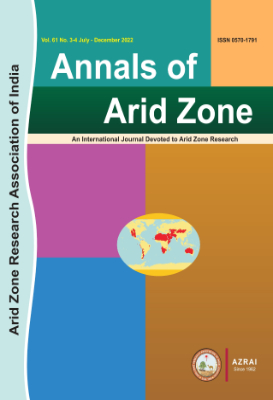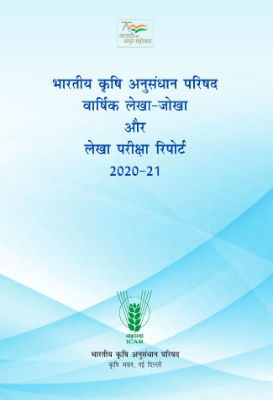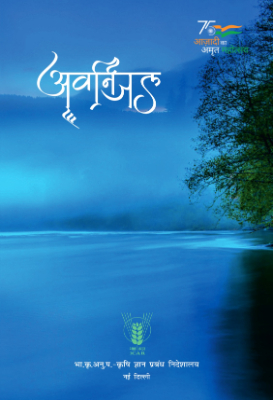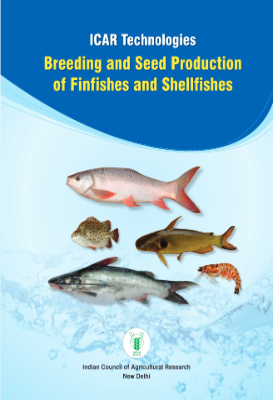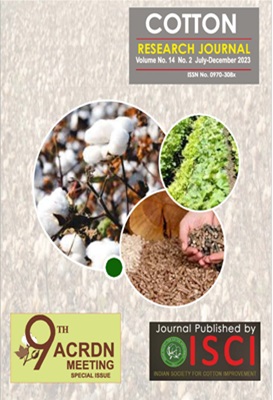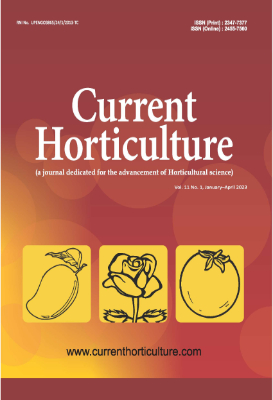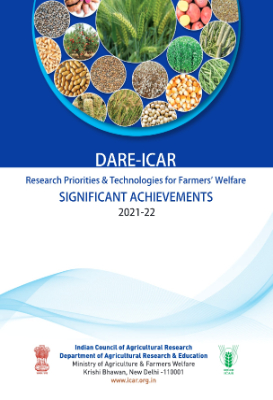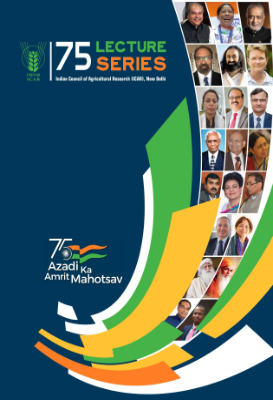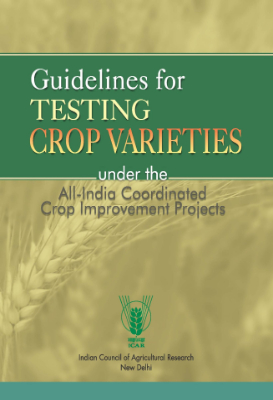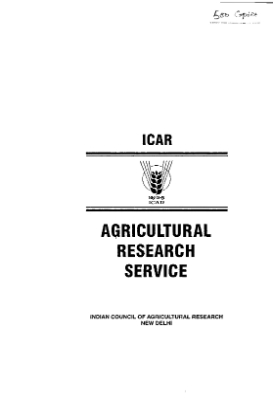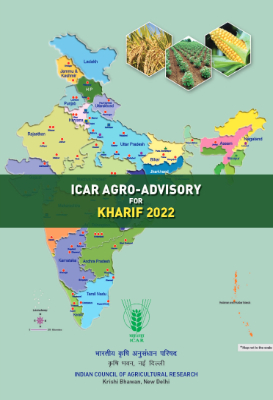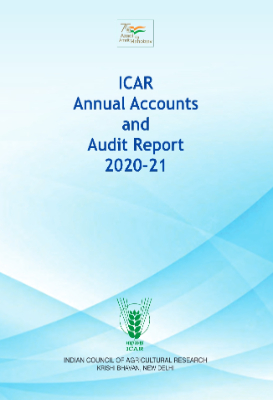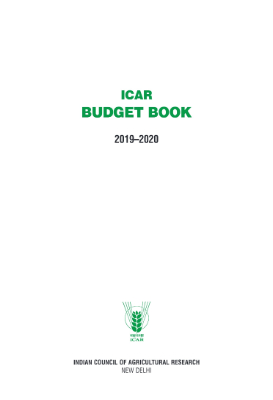E-Resources
Agricultural Economics Research Review
Focus and Scope The Journal regularly publishes refereed research articles, reviews, research notes and communications of high impact in basic and applied research on economic and policy aspects of agriculture and rural development. Comprehensive review articles in the area of agricultural economics (including livestock, horticulture and fisheries), conference/symposia proceedings and book reviews are also published in the Journal. To encourage the young researchers, recent abstracts of M.Sc. and Ph.D. theses in agricultural economics and policy research are also published. Peer Review Process Preliminary Scrutiny The Journal has a Preliminary Review Committee comprising Members of Editorial Board and Executive Committee, which makes preliminary evaluation of the merits of a paper in terms of sending to a referee or rejection at the preliminary stage itself. Open Access Policy This journal provides immediate open access to its content on the principle that making research freely available to the public supports a greater global exchange of knowledge. Sponsors Indian Council of Agricultural Research Journal History The journal Agricultural Economics Research Review is being published regularly since 1988.
Annals of Agricultural Ressearch
The Indian Society of Agricultural Science was established in 1979. The Society is an umbrella society which provides an opportunity to agricultural scientists belonging different disciplines to address the problems confronting Indian agriculture in a concerted and integrated manner. The name of the Society shall be "THE INDIAN SOCIETY OF AGRICULTURAL SCIENCE (ISAS)". The head office of the Society shall be at the Indian Agricultural Research Institute, New Delhi-I 10 012.
Annals of Arid Zone
Focus and Scope The Annals of Arid Zone is a open access journal totally devoted to dryland and arid zone research. The Journal accepts the original research and review articles covering diverse fields like dryland agriculture, crop management, soil-plant-water relationship, range ecology and management, solar energy utilization, desertification, rangelands, sand dunes, livestock, agroforestry, wind erosion, watershed management, biodiversity, integrated farming systems, climate change, hydrology, etc. publishes the findings of research relevant to dryland in general and arid zone (hot and cold) in particular. Peer Review Process The research/ review article within one week of its submission is sent to two different independent referees. They are selected on basis of their expertise in areas of paper received, have ability to logically comments based on the content, with no conflicts of interest and also reliable to do review in the given timeframe. Referees are expected to respond to the editor's request for advice within a limited period of time (3 weeks), which is clearly stated by the editor. A comment sheet is also provided to him for seeking his advice on all aspects of the article. He is advised to return the manuscript immediately without comments if it is not possible for him to attend to a manuscript within this period, so that the editor can send it to another referee without further delay. Generally 6 weeks' time is given to the each reviewer for completion of review the research article. Comments from the referee are received by the editor within the stipulated timeframe If the reports of both referees disagree with regard to the suitability of the paper for publication, advice of a third referee is sought. Comments received from both referees: Article is sent to author for modification along with comments of referees. At this stage editor completes the preliminary editing. It includes checking in-house style (presentation of title, affiliations, present address, abstract, scientific nomenclature, text and reference presentation as per the Journals' format). Comments not received from both referees: If comments are not received from both referees within the stipulated timeframe, reminder is sent to them. Reminder to referee from whom the comments not received: If comments are not received from either of the one referee within the stipulated timeframe, reminder is sent to him. However if his reply is not coming in a stipulated time, editor takes suitable action on the basis of comments received from one referee. In case of no reply from both the referees the article is sent to a new referee. Rejection of the article on the basis of comments of referees: The article is rejected on the basis of comments of referee/referees. The author is informed accordingly. Author does not agree with the adverse comments of one referee or in the meantime suitable comments are received from Second referee: Editor's decision independently or in consultation with editorial board, is final. Editor may ask the first referee or a third referee to go through the comments of first referee, reply of author to comments of referee and /or contradictory comments of second referee. Favorable comments are received from second referee after the modification: Input of the second referee is incorporated in modified article. Author is contacted if referee asks for inclusion of more information in the form of table, figs or references. Adverse comments received from the second referee at any stage: Author is informed of the adverse comments from second referee and action is stalled (even at proof stage) till final decision. Editor's decision independently or in consultation with editorial board, is final. Acceptance of the article is sent to author. Plagiarism: Plagiarism will be checked by iThenticate software. Articles/ manuscripts with text resemblance less than 20 % (excluding standard text in methods and references in text as well as bibliography) will be only be excepted for publication. Publication Frequency The journal is published quarterly. Open Access Policy The Journal is available as Open Access under the Creative Commons Attribution-Non Commercial-Share Alike 4.0 International License. Ethical Policy Our interaction with our authors is built upon a foundation of trust, and we operate on the principle of good faith when it comes to publishing submitted materials. We uphold the belief that every author, referee, and editor should openly disclose any conflicting or competing interests tied to a specific article. Our evaluation of manuscripts is impartial, irrespective of authors' attributes such as race, gender, religious beliefs, ethnicity, citizenship, age, or reputation. We exclusively consider fresh submissions that have not been previously published or simultaneously submitted elsewhere. It is imperative that the reproduction of content from other papers be accompanied by appropriate source credits, and any form of plagiarism, whether it involves the uncredited use of external text or the creation of multiple papers with substantially similar content by the same authors, is strictly prohibited and is sole responsibility of the author. Simultaneous submission of identical findings to multiple journals is deemed unethical, with exceptions granted to review articles that include proper citations. Authors are responsible for acknowledging the contributions of other researchers that have influenced their research and should duly reference the publications that have shaped the trajectory and progress of their study The Publisher will address the matters related to authorship and contributorship, managing complaints and appeals, addressing allegations of research misconduct, handling conflicts of interest, ensuring ethical oversight, addressing intellectual property rights (IPR) concerns, facilitating post-publication discussions, and managing corrections and retractions. Throughout this process, we adhere to the guidelines set forth by the Committee on Publication Ethics (COPE) Sponsors ICAR-Central Arid Zone Research Institute, Jodhpur-342003 Journal History The Arid Zone Research Association of India, Jodhpur (India) (AZRAI; Regd No: 17988/69) was formed in 1962 to disseminate research findings related to a variety of issues through interdisciplinary researches concerned with the development of arid zone. A quarterly journal, Annals of Arid Zone was started in 1963. Recently the association has published 54th volume of Annals of Arid Zone in 2015.
AZADI Ka Amrut Mahotsav Commemoration of 75th year of India?s Independence Programmes & Activities
The post-Independence journey of Indian Agriculture has been quite
impressive despite several limiting factors such as uncertainties of weather,
declining soil health, increasing atmospheric temperature and emergence
of more virulent pests and pathogens. The production of food grains, fruits,
vegetables, milk, meat, egg and fish has increased significantly. Systematic
and strategic research has led to development of new technologies to address
specific needs of the farmers. These are being disseminated through the
network institutions in the National Agricultural Research Education and
Extension System (NAREES), regular interaction with state governments
and other stakeholders, and increased use of digital platforms for
communication. Still there exist gaps in transfer of technology/ information
from lab to land. There is a need to strengthen our communication amongst
all stakeholders. The 75th Year of Nation's independence is being celebrated
as Azadi Ka Amrut Mahotsav. The DARE/ICAR has planned various activities
to be undertaken for 75 weeks preceding 15th August 2022. These include
awareness campaigns and lectures by eminent persons on the thematic
areas for reaching out to maximum stakeholders particularly farmers on
various new developments in different sectors of agriculture. This journey
of 75 weeks shall culminate with congregation of farmers who have been
successful in doubling their income, students and academicians with
release of the compendium on farmer's success stories. It is also proposed
to bring out a book on "Indian Agriculture: A Saga of Success-Role of ICAR
through Different Revolutions" and get it released during the occasion.
The proposed activities and campaigns during the 75 weeks of "Azadi ka
Amrut Mahotsav" have been compiled to provide a glimpse of our efforts.
I hope it would be interesting and informative to all the stakeholders.
The feedbacks and suggestions to strengthen our activities in future are
welcome.
Biofortified Varieties: Sustainable Way to Alleviate Malnutrition Third Edition
Nutrition plays central role in growth and development of healthy mind and body. We are
committed to providing a better and sustainable future for all the citizens through nutrition
and food security. Our aim is to ensure healthy lives and promote well-being of people of all ages
through nutritious food. It has been estimated that alleviating malnutrition is one of the most
cost-effective measures, with every $1 invested in proven nutrition programme offering benefits
worth $16.
ICAR has developed 87 biofortified cultivars in 16 crops that can be integrated into the food
chain to enable better health of human and animal populations. Of these, 48 cultivars are multinutrient-dense in nature with two or more traits combined in a single genotype. Dedication
of biofortified crop cultivars on October 16, 2020 (World Food Day) and September 28, 2021,
respectively by the Hon?ble Prime Minister to the nation is a testimony to the commitment
of the country and of the Indian Council of Agricultural Research (ICAR) towards fulfilling
country?s food and nutrition security. This bulletin entitled, ?Biofortified Varieties: Sustainable
Way to Alleviate Malnutrition? highlights the yield potential along with respective nutritional
characteristics of the varieties for propagation and use in the country. I do hope that the
information contained in this bulletin will be of immense use towards building a malnutrition
free India.
Cotton Research Journal
One of the early actions of ISCI has been the launching of a research journal to fill the vacuum created by the stoppage of predecessors like (a) the Indian Cotton Growing Review published by the Imperial Cotton Growing Corporation of UK and (b) the Indian Cotton Development Journal published by the Directorate of Cotton Development. For many decades, these journals had remained as vehicles for research findings on cotton production technologies in India. By 1970 both these journals ceased to appear. The inaugural issue of the ISCI Journal was published in January 1976, since then the periodical has witnessed increasing patronage from cotton scientists from all over India and abroad. By 1990s, the 6- monthly journal had transformed into a quarterly publication to accommodate the rising number of articles originating from ICAR institutes and agricultural universities in which government funded research programmes were on the increase.
Crop Cultivars Developed Through Molecular Breeding
I
ndian Council of Agricultural Research (ICAR) from its inception has spearheaded country?s
preparedness towards feeding the ever-increasing population. The development of improved
high yielding varieties during 1960s made significant increase on food production through
?Green Revolution?. So far, 5800 cultivars of different field crops have been released for cultivation
in various agro-ecosystems of the country. However, development of cultivars takes quite
long time, which generally takes 10-12 years. Taking the help of modern tools, scientists have
been able to curtail the breeding cycle to develop cultivars much faster. ?Molecular Breeding?
technology provides significant advantage over ?traditional breeding? methods, where (i) the
target gene is selected with more precision, (ii) desirable plants are selected at the seedling stage
much before expression of the trait(s), (iii) costly and cumbersome phenotyping during the
breeding programme is bypassed, and (iv) breeding cycle is significantly shortened to 5-6 years.
Using ?Molecular Breeding?, 74 varieties in seven crops namely, rice, wheat, maize, pearl millet,
chickpea, soybean and groundnut have been released for commercial cultivation in India.
It includes, 43 in rice, five in wheat, six in chickpea, six in soybean, two in groundnut, 10 in
maize and two in pearl millet with improved biotic stress resistance, abiotic stress tolerance and
nutritional quality.
This bulletin entitled, ?Crop Cultivars Developed Through Molecular Breeding (second edition)?
highlights the salient features of the varieties and hybrids developed through accelerated
breeding. I dedicate this information bulletin to all our farmers with a hope that these varieties
will reduce the risk due to climate change and enhance their income.
Current Horticulture
Since its establishment in 2013, 'Current Horticulture' has been a cornerstone publication in the field of horticultural science. Published by the Society for Horticultural Research and Development, the journal has played a pivotal role in advancing knowledge and fostering collaboration within the horticultural community. With its inaugural issue marking the beginning of a journey towards excellence, 'Current Horticulture' has consistently upheld a commitment to quality and innovation. Over the years, the journal has evolved into a platform where researchers, scientists, academicians, and stakeholders converge to share their latest findings, insights, and advancements in various facets of horticulture. From plant cultivation techniques to breeding methodologies, from genetics to pest management strategies, each issue of 'Current Horticulture' showcases a diverse array of articles that contribute to the collective understanding of horticultural practices. Its publication schedule, releasing three issues annually in April, August, and December, ensures a steady flow of cutting-edge research to the global horticultural community. Through its dedication to excellence, 'Current Horticulture' has earned recognition as a leading publication in the field, driving innovations and shaping the future of horticultural research and development. The journey of 'Current Horticulture' since its inception in 2013 exemplifies a commitment to scholarly excellence and advancement in horticultural science. As a publication of the Society for Horticultural Research and Development, the journal has served as a beacon of knowledge dissemination, providing a platform for researchers and practitioners to share their insights and discoveries. With its inaugural issue, the journal embarked on a mission to elevate the discourse surrounding horticulture, covering a wide range of topics including plant cultivation, breeding, genetics, pest management, and post-harvest technology. The triannual publication schedule, releasing issues in April, August, and December, ensures a regular influx of cutting-edge research from around the globe. 'Current Horticulture' has become synonymous with quality and rigor, attracting submissions from esteemed scholars and experts in the field.
DARE-ICAR Achievements 2021-22
The strong collaboration of ICAR with other stakeholders at grassroots
level continued backstopping towards nation?s food and nutritional security
despite of challenges such as biotic and abiotic stresses in agriculture and
Covid pandemic. The major accomplishments of ICAR during 2021-22 are
precisely presented in this document.
The achievements are grouped into different themes. The release of 389
crop varieties, production of quality breeder seed and planting materials
and promotion of agricultural exports marked the impact of ICAR
technologies. While, the release of biofortified crop varieties, strengthening
POSHAN Abhiyan, promoting startups and entrepreneurs in food processing
especially in millets contributed significantly in enhancement of nutritional
outcome. The climate resilience in agriculture was addressed by releasing
resilient varieties, capacity building in new resilient villages, and revalidating
agriculture contingency plans of 15 districts. In addition, chemical free
agriculture, water footprint reduction, disruptive innovations for smart/precision agriculture summarizes R&D efforts for enhancing respective
resource use efficiencies at field level.
The major achievements in animal productivity and health management
were documentation of indigenous animal breeds, cloning technology
in breeding, feed supplement formulations, dairy technology, and Serosurveillance of animal diseases. The research breakthrough in aquatic
sector is summarized in Blue Revolution. The innovations in farm and postharvest equipments, processing protocols, and storage are covered under mechanization and reduction of post-harvest losses.
During the period, the agricultural education was strengthened through
revision of UG and PG course curricula, quality assurance in higher agricultural
education and enhancement in number and amount of scholarships. Further,
approval of road map for the implementation of New Education Policy 2020
and constitution of a committee for developing syllabus and curricula on
natural farming were the efforts to align agricultural education with National
Educational Policy.
The Lab to Land outreach by KVKs helped ICAR to reach the unreached
through establishment of new KVKs, conduct of FLDs, skill development
trainings, extension activities, and supply of large quality of seeds and
planting materials. Besides, documented ~71000 success stories of farmers
towards Doubling of farmers? income. Effective use of ICT in decision making
and marketing of farm produce for empowering farmers is summarised
under digital linkage with farmers.
The document is an effort to provide a glimpse of ICAR?s R&D achievements
during year 2021-22 under the guidance and supervision of Dr. T. Mohapatra,
former Secretary, DARE and DG,ICAR and support of Dr. Himanshu Pathak,
Secretary, DARE and DG, ICAR. The inputs from all the SMDs/Units are duly
acknowledged with thanks to all the DDGs/ADGs and concerned personnel.
The support of Mrs Suman Khurana, Senior Technical Officer of PIM section
is highly appreciated.
Ex-Situ Crop Residue Management
THE Committee on economic analysis of alternative/ex-situ options of
crop residue management likes to express its sincere and whole hearted
thanks to Dr. Trilochan Mohapatra, Secretary, DARE and DG, ICAR for his
foresight in formulating concepts and ideas for ex-situ management of crop
residues, for instituting this Committee and further for providing his
valuable inputs at various stages for finalizing the "Ex-situ Crop Residue
Management Options" document.
The Committee also extends its sincere thanks to the AS (DARE) and
Secretary (ICAR), Secretary, Ministry of Power, and Secretary, Ministry of
Petroleum and Natural Gas and Director, ICAR-NIAP for valuable guidance
all through for drafting the recommendations.
Thanks are also due to all the members of the High Level Monitoring
Committee on In-situ Crop residue Management Central Sector Scheme,
Director ICAR-CIAE, Bhopal, Dr. KC Pandey, Project Coordinator of AICRP on
Energy in Agriculture and Agro Industries, Dr. Nalini Ranjan Kumar, Principal
Scientist, ICAR-NIAP, Dr. S.S. Sooch, Principal Scientist (Renewable Energy
Engineering), PAU, Ludhiana, Dr Mukesh Jain, Assistant Professor (FMPE),
CSHAU, Hissar, Dr. Panna Lal Singh, Principal Scientist, Agricultural
Engineering Division, ICAR for their outstanding support and cooperation
during the process of discussions and in finalizing the recommendations.
Member Secretary of this Committee Dr. Kanchan Kumar Singh, Assistant
Director General (Farm Engineering) is appreciated, by the rest of the
Committee, for his strenuous efforts in collating the information and drawing
a conceptual framework that formed the basis of our discussions and for the
overall coordination in formulation and finalization of the recommendations.




